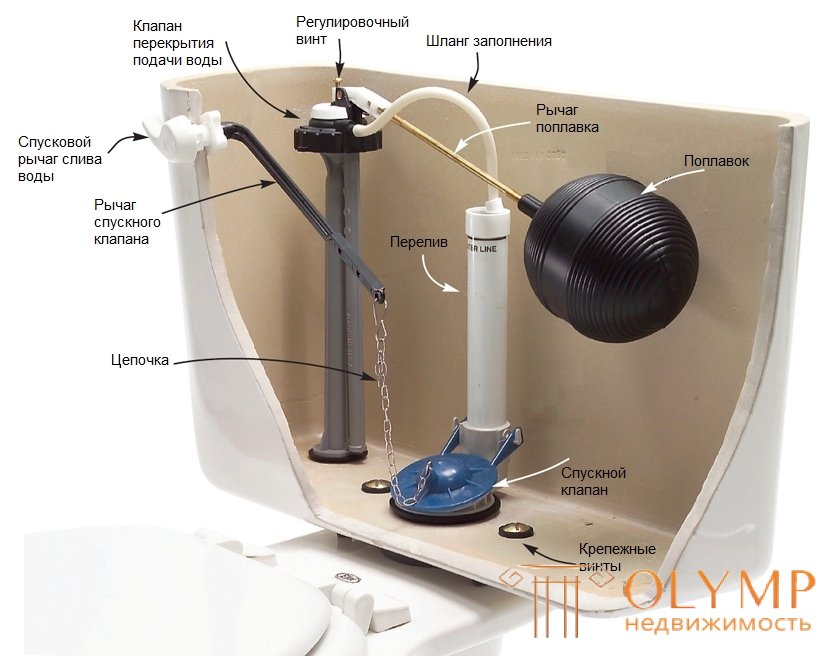
If you put in your house a new plumbing, including a toilet, be sure to pay attention to the accuracy and reliability of the connection of all components of the equipment. From the tightness of the joints depends on the smooth operation of the device.
A working toilet brings a high level of comfort to your home. However, any plumbing may break. Especially often troubles occur in old devices. The poor quality of the water has a destructive effect on the components of the toilet bowl drain system. Hard water with extraneous impurities gradually disables equipment. Every homeowner should know how to fix the toilet cistern.
At first glance, the drainage system in the toilet looks quite simple - it is a earthenware or plastic tank that is automatically filled with water, which is then used to flush out the sewage.
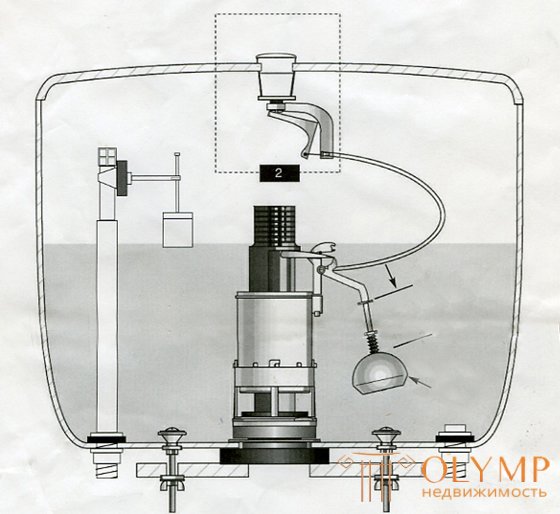
The device of a two-regime drain tank with a drain column
Such basic elements of the cistern are available in almost all models, even in older devices of the Soviet period. They may differ in the materials of execution and in appearance, but their main tasks: control of the set and the initiation of water flow remain the same.
The main types of toilet cistern designs are the float mechanism and the drain column.

The toilet bowl device with the lever of discharge and the float-operated mechanism
The following figure shows the device of a classic cistern with a float mechanism. These internal fittings were equipped with drain tanks of the Soviet period and are still being used on devices with a side drain lever.
All major components of the flush tank are interconnected. Damage to one element can cause damage to all equipment.
One of the most common breakdown mechanisms of the toilet cistern is a constant flow of water. The reason is a malfunction of the float device, which should turn off the water supply to the tank when it reaches a certain level.
The main reasons for this behavior of the float mechanism may be the following factors:
In older models, inspect the float. This is a hollow plastic container. From long-term operation, cracks can form in it. Then inside the float gets water from the tank, and it sinks. Such a node is the easiest to replace - the float is usually mounted on a screw with a nut.

The device float valve in the toilet
In modern models of cisterns, there is no hollow plastic float. The inlet valve is closed by another node - a drain column, which is easier to replace as a whole. Some models of drainage columns have an adjustment mechanism that determines the level of filling of the tank and the amount of discharge water.
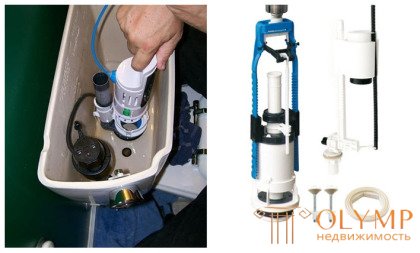
The device drain mechanism in modern tanks
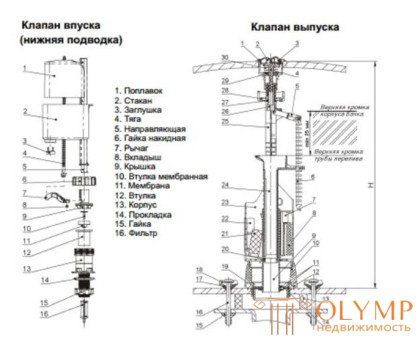
Device drain column
Another reason for the constant drain may be the failure of the intake valve . In this case, despite the correct operation of the float mechanism, the tank is constantly filled with water and constantly drained. Valve failure may occur due to surges in water pressure in pipelines. In this case, the valve is the easiest to replace - it is a fairly simple device that can be found in almost any hardware store. Remove the valve and purchase the same.
A constant flow of water from the tank to the toilet can also occur due to the breakage of the release valve . This device should not be repaired, it is better to replace it entirely with an identical one. If, after dismantling the exhaust valve, it is found that the rubber siphon gasket is worn out, it should be replaced. This item is not expensive.
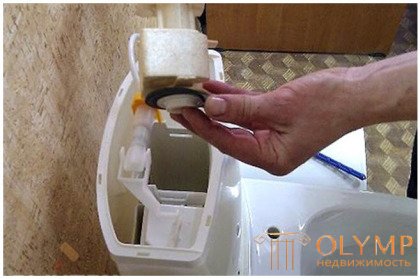
Replacing the rubber seal on the exhaust valve
The noise of the water filling the drain tank can cause discomfort among your household. Usually this problem occurs in the toilet cisterns with the upper supply of water. This problem is easily fixed in two ways.
Now the water will not make a "waterfall", and quietly through the tube will fill the tank capacity.
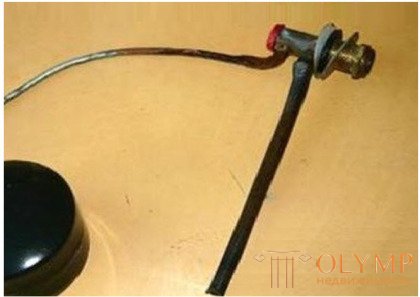
Plastic tube at the inlet to reduce the sound of water
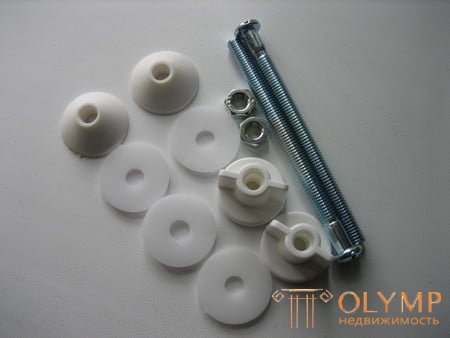
Modern hardware galvanized (or made of stainless steel) and
supplied with plastic or metal washers and rubber gaskets
Most models of toilet cisterns are attached to the shelf with bolts that pass through the bottom of the tank. Metal bolts are corroded and may rot over time. Water in such a case will leak through the holes, drip onto the floor.
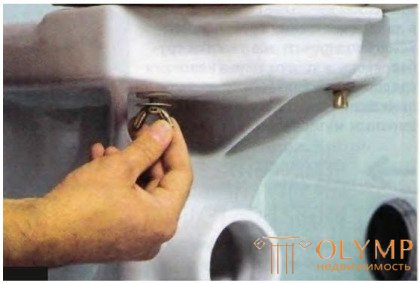
Fastener bolts may have ears

Fixing the toilet bowl to the shelf with bolts
The reason that your toilet cistern is no longer filled with water can be three types of faults.
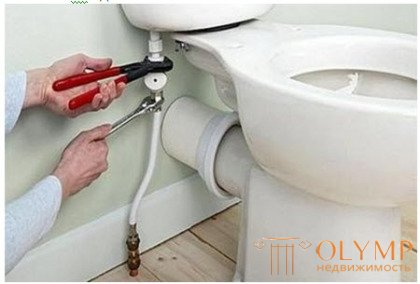
Replace flexible supply hose
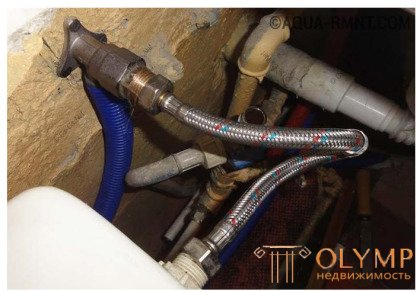
Side connection for flexible hose
Faults in the tank fittings can occur as an avalanche. In this case, you can not change the worn parts, and replace the internal reinforcement of the drain tank entirely. Examine the valve device available in your tank. Drain tanks with various structures of internal fittings are produced. In particular, cisterns for toilet bowls differ in the type of water supply - a flexible hose can be connected to the top, side or bottom of the cistern .

Fittings kit for cistern
We will understand how to replace the internal reinforcement on the tank with the lower water supply . To carry out these works requires a minimum set of tools: wrenches and pliers.
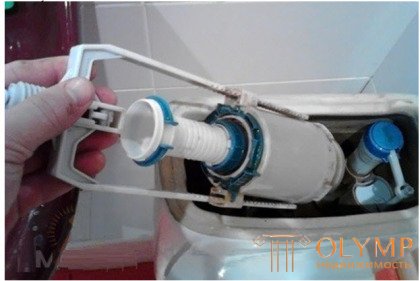
Dismantle the old drain column

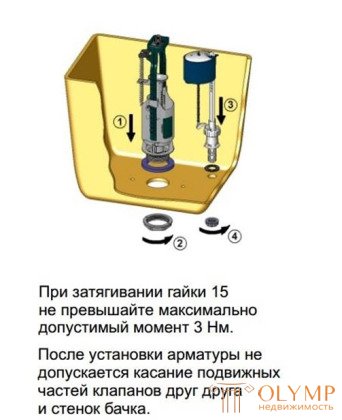
Installation in a tank of a new drain column
Installing a new column
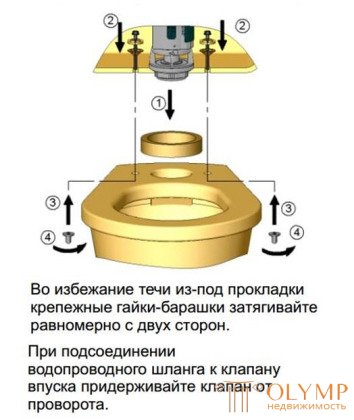
Installing a new toilet cistern on the toilet
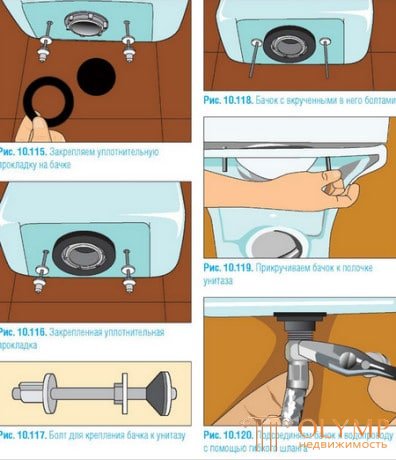
It is important to install a gasket between the tank and the bowl without tilting, do not squeeze the bolts.
To eliminate leaks in the tank, you must carefully check all the places of threaded connections. You can put under them pieces of toilet paper or paper napkins, which will be visible even the smallest drops. When leaks are detected, the junction of the pipelines is reassembled using additional sealing tape.
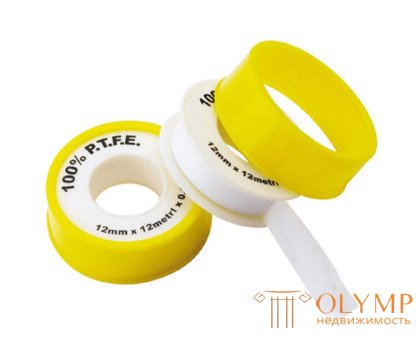
Sealing tape for threaded pipe connections
Any internal components of the toilet cistern can be replaced. But this can only be done if you find an identical device.
Every year tanks with new designs of internal reinforcement appear on the market, which may be incompatible with previous generations. In this case, having run around the shops, you can make a decision about buying a new tank. It is easier to resolve this issue if the toilet and the toilet bowl are made as separate structural elements in your toilet. There are models of sanitary equipment, in which the tank and the toilet bowl are made as one unit.
Replacing the toilet bowl is also subject to detection of cracks in the sanitary ware. In this case, no repair will help the case, the process of destruction is irreversible. Drying the tank and applying a thick layer of silicone sealant on the crack area can be a temporary measure.
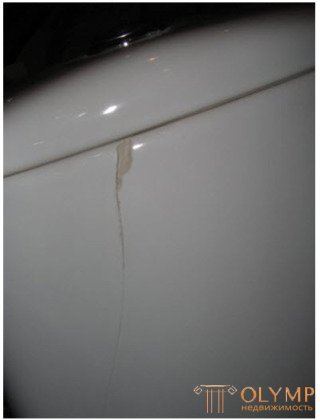
Crack in the cistern
As you can see, the cost and duration of repairing a toilet bowl depends on the nature of the damage. Some faults can be eliminated by replacing the elements of internal reinforcement. In case of detection of cracks in the casing of the tank, or the inability to purchase suitable fittings, it will be necessary to fill up the drain tank, and, possibly, the entire toilet bowl set.
Что бы оставить комментарий войдите
Комментарии (0)